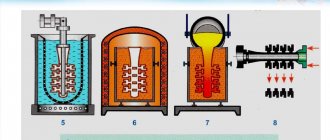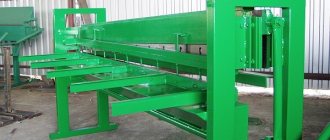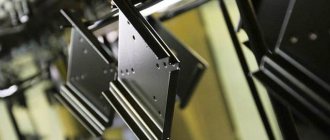Stamping is one of the most profitable methods of processing steel by pressure. It requires a press, a washer and a matrix, a mold, and scissors. Depending on the operation (bending, cutting, drawing, etc.), different molds are needed. The metal is stamped, both hot and cold.
Making a mold is a long and expensive process that requires a high level of preparation. You cannot do without a mold when producing multi-production parts: expensive equipment lasts a long time and leads to a reduction in the cost of the final product.
Plastic injection molding at home
This video lesson from the OchumeletsTV channel is about how to cast plastic at home.
Molten plastic is not completely liquid. This is a thick mass, so it is poured under pressure. To create it, the master made a metal syringe. I used a plumbing squeegee. Piston. Guide. Solid mold. Made from epoxy resin. Make a screw lamb. Polypropylene was used as a raw material. From an old box. At home, it is better to cast polypropylene and polyethylene, since these plastics are non-toxic.
When heated, they do not emit harmful products. Fill small pieces into a syringe. We put it in the oven at 220-240 degrees. The part is simple, so the plastic should not be overheated. While the plastic is heating up we will assemble the mold.
First, secure the bolt to the required distance. Just pull by hand, no wrench needed. The pressure is not so high. To prevent the bolts from moving back and forth, we use a cap. Chipboard material. Install the cover and tighten it with nuts. We will pour plastic into the hole.
30 minutes have passed. We put on special gloves and take out the syringe. Let's quickly wind it up. Apply pressure to squeeze out the plastic. Installed on top of the mold. Let's press. We wait a certain time. It must be kept under pressure to minimize shrinkage. Let's analyze the form and see what the product turned out to be.
It's obvious that everything has spilled. Let's extract it. The detail worked. The bolt is well filled and sits firmly. The protrusions can be trimmed. This way you can do polypropylene casting, etc. at home. This is the most primitive artisanal method. So that the product can be cast quickly and easily.
Injection Molding Basics
Injection molding is a relatively old technology, having been used since the late 1800s. Injection molding machines
have a huge screw (auger) that directs the molten plastic into the mold under high pressure. This screw drive method was invented in 1946 and is still used today.
Injection molding machines are, of course, not the same as today's high-tech 3D printing machines. There's nothing innovative about them, but injection molding is a requirement for most new hardware products.
The injection mold consists of two halves ( matrix and punch
), which, when closed, form a cavity in the shape of the desired part. Hot liquid plastic is poured into it under high pressure.
High pressure is necessary so that the plastic, in a viscous flow state, fills every corner of the mold cavity.
When the plastic cools, the two halves of the mold move apart and the finished body part is removed from them.
Developing the design and construction of a housing for mass production is a fairly complex task, and the cost of the molds themselves is in the tens of thousands of dollars. Yet injection molding remains one of the most sought-after technologies because it allows the production of millions of identical parts at an incredibly low cost per piece.
Mold making
Next, watch a video on how to make a mold for pouring plastic.
Polypropylene casting machine
The author of the OumeletsTV channel showed a self-made machine for home plastic molding. It's electric. The piston is manual. Thermostat for precise temperature control. The video shows his tests. For these purposes he will cast nylon or polyamide. There is another name - nylon. Chair crosspieces are usually made from nylon. The master found just such a thing, he crushed it. Before use, the mug must be dried at a temperature of up to 100 degrees. This must be done within 2-4 hours.
Load the granules into the machine. Let's set it to 250 degrees. This is the optimal temperature for polyamide casting. Let's wait until the required degrees are reached. Then we will install the piston. The machine has reached optimal mode, the indicator light is on. Now you need to wait 5 minutes for the plastic to completely warm up from the inside.
The polyamide has warmed up. We put it on the mold. We press in. We do pressure aging. It's obvious that he's flooded. Let's let it cool a little. Now let's disassemble the mold. Studied plastic product. As you can see, there is no shrinkage.
Main stages of mold design
The basis for any product made from polymer raw materials is its three-dimensional model. Large manufacturers do not always have their own designers, CAD systems and their own database of design developments, although this greatly simplifies communication with the contractor who makes the molds. If the customer only has a prototype of the product or a photograph, then he will have to create a 3D model either with the involvement of independent specialists or at the manufacturer.
Using only design documentation is undesirable, especially in the case of products with complex geometric shapes - there is a fairly high probability of an error when creating a PF, which will only be noticeable on the finished product. 3D modeling ensures that all cavities of the manufactured tooling will exactly match the geometry of the required product.
It is critically important to take into account the dynamics of filling characteristics with molten plastic, especially if a mold is designed for products of complex geometric shapes, with thin-walled elements, made of polymers with specific plasticization properties. If for simple products an engineer takes into account the features of foundry processes in a PF, using his own experience, then for products more complex than a flower pot or bucket, it is necessary to mathematically model the filling of the mold. Modern software (Magma, ProCast, CastCAE, Moldex3D, etc.) allows you to quite accurately predict the behavior of molten plastic, evaluate its shrinkage and make changes to the design of the mold at the design stage, not in the metal. This is much cheaper and easier than trying to perfect already manufactured equipment.
An integral part of the model is the technical specification for the manufacturer, which describes the requirements for metal, dimensions and weight of the PF. It is necessary to take into account the characteristics of the injection molding machines used in the customer's production, since sometimes manufacturers take the path of least resistance. To increase the rigidity of the mold, they increase the wall thickness and dimensions, which can create problems when installing equipment on injection molding machines.
Plastic injection machine at home
Below is a video explaining how to make a plastic injection molding machine. What do you need for this in a DIY home environment? Rod with piston. Three-quarter pipe as a cylinder. Half inch adapter to 3/4 pipe. Fitting cut off for convenience. Metal gasket with mica for insulation. Thermostat. It regulates temperature up to 350 degrees. 600 watt ten. Two nuts and a box for attaching the thermostat. We put on the adapter. We tighten the washer. To prevent the nichrome from sliding down.
We begin to assemble the control unit. Then we attach the thermocouple from the thermostat to the cylinder body. The author did not show how he would assemble all this, but presented a diagram. The photo shows the device assembled.
We attach the control unit to the syringe. Tighten with nuts. The thermocouple is long enough. Now you need to secure it. Mica to prevent thermocouple from slipping through ceramic insulators. For rewinding, not just a thread is used, but a silica one. It is heat-resistant, that is, it does not burn or melt. You can use asbestos cord. But since the master did not have it in stock, he had to buy silica.
We wrap it with heating element. Next, you can use mineral wool or asbestos fabric. Necessary to avoid heat loss. The master used mineral wool from an old oven. Fixed it with aluminum wire. Assembly is complete. Pressure tests can be carried out.
Set the thermostat to 100 degrees. Let's see how the machine will work in this mode at home.
How to make a mold
Mini-TPA does not require a full-fledged mold for casting plastic parts.
It is enough to make a form-building part that is part of any mold.
The form may consist of one, two, three, and so on parts. The main thing is that they must be tightly connected and kept assembled at the moment of plastic injection. Then, after injection, the mold should be easily disassembled into its components, and the part itself should be easily removed after casting.
Making a mold will be shown using the example of the task of casting a cord clip . This example is for a machine with an automatic clamping unit; modifications for a manual machine are also described below.
1. Draw the product.
2. Since the part is small, several such parts can be cast at a time. It was decided to cast 2 pieces at a time, since a small number of products are required.
A computer model of half the mold containing 2 parts is drawn. The injection is planned in the middle between the products. Since the requirements for the product are not high, it is customary to make the casting channels wide for easier casting.
There are threaded holes in the corners.
You can download a zip archive with files of this plate in stp and iges format from this link.
3. The front plate (the second half of the mold) is a smooth surface with a hole in the middle for the MiniTPA nozzle and also four threaded holes for fastening.
4. For ourselves, we have developed a set of frames for attaching various-sized forms with many through holes and with large holes in the corners for mounting on guides.
Subsequently, we abandoned the frames in their original form, leaving only vertical parts with bronze bushings.
Forms are attached to the holes; the hole dimensions for our case are indicated on the “Drawings” page. You have the right to choose them and arrange them as your detail requires.
5. We assemble the entire structure on the machine and make a test casting. All is ready.
6. In our case, we modified the mold, equipping it with pushers for automatic operation.
An example of work is shown in the video below:
Manual casting mold on the desktop
A mold for manual casting will have a minimum of differences: there is no need to make a hole in a flat plate - injection will occur along the line of closure of two plates (half-molds).
The form will need to be pinned to your desktop. The top lever will keep the mold from opening, the second will move the entire work table towards the injection nozzle.
We hope this information will be useful to you when designing and making your mold.
Making double dowels for installing heated floors
According to the above algorithm, a casting mold was designed and tested
double dowel for installing heated floors.
Form
The mold was made of aluminum for two reasons. The first is to test one hypothesis (technical solution), the second is to minimize risks in case of failure and at the same time save money in case of success. Everything worked out.
Manufacturing methods
There are three ways to make a stamping mold:
- Remaking an existing mold;
- Manufacturing from scratch;
- Assembly from ready-made materials.
The first option is extremely rare due to the costs; it’s easier to do it yourself. In the CIS countries they create forms from columns to form-building ones. There is a trend towards specialization of molds. All parts of the mold are made in different factories, and finally they are assembled into the finished product.
The production of molds for stamping aluminum parts is reduced in cost by reusing, without repairs, molds that have already served their purpose on more high-precision parts. Aluminum parts do not have tight tolerances, so this option is acceptable.
Making plastic products and molds with your own hands
A business idea for organizing small-scale production of products from various injection molding materials at home. Thanks to innovative technologies, today in the production of plastic products it is possible to do without expensive automatic thermoplastic machines. Moreover, you can set up small-scale mini-production right on your desktop. This business idea can be considered in two directions:
- As the main business of manufacturing finished products and molds by casting from: liquid:
- plastic;
- silicone;
- polyurethane;
- transparent resins and other materials.
- Mold making as an effective addition to other types of business in the area:
- construction;
- Food Industry;
- soap making
In the first and second cases, casting at home does not require large financial investments. You can start an injection molding business simply now.
Manufacturing using liquid plastics
The manufacturing process is carried out using liquid plastics and silicone molds. Now it is possible to produce plastic products in small batches at home:
- souvenirs;
- toys;
- costume jewelry;
- spare parts for auto tuning;
- spare parts for various mechanical devices;
- shoes;
- dishes
There are components for the manufacture of parts from thin-walled plastic, which can significantly expand the range of products and produce parts of any complexity. For example, mixing two components of the Axson FASTCAST F32 brand from a French manufacturer makes it possible to obtain a super-liquid plastic that flows into the smallest folds of the relief of the model’s shape. In addition, it is harmless to children and has no odor.
Material selection
High-strength steels that can withstand impact loads are used for molds. These steels are highly hardenable and have high toughness. The most commonly used are 40Х13 and 5ХНМ. For dies, durable steels St45, St40X, U8 are chosen.
For cold stamping, a hydraulic press is used due to the variety of its configurations and low metal consumption. For cutting and punching, choose a tool with a large washer stroke.
IMPORTANT! U8A and 8HF steels are not used for the manufacture of mold parts. U10A steel is hard after heat treatment, but parts manufactured with it will have to be subjected to additional machining.
Pre-production
To organize production, you will first need a sample model. Using it, you first need to make a mold from special silicone or polyurethane components. With experience and the quality of materials, you can learn to remove molds from models at such a high level that fingerprints will even be visible on the products (if necessary). That is, the copy will be at the level of identity, which cannot be distinguished with the naked eye. Plastic products can be given complex compounds with any relief. If there is no ready-made model for a sample, but you need to make unique products, you can order it from the owners of a 3D printer. By the way, casting significantly exceeds the productivity of 3D printing from plastic.
When your product is ready, you can design it using related products that come with liquid plastics:
- paints for artistic effects;
- primers;
- glue.
Naturally, in some cases you cannot do without creativity, and you will have to manually paint the products, which may affect productivity. But creating every business is undoubtedly a creative process. After all, financial management is an art.
Features of the technology
The raw material for stamping can be a metal sheet, steel strip or thin tape. Cold sheet stamping has become most widespread for a number of reasons. Hot stamping technology is used in cases where the power of the equipment used is not enough to deform the metal in a cold state or when it is necessary to process a part made of metal with low ductility. As a rule, hot stamping technology is used to process sheet blanks whose thickness does not exceed 5 mm.
Depending on what needs to be done with sheet metal during the stamping process, separation and form-changing technological operations are distinguished. As a result of the first, a part of the metal is separated from the workpiece, which can occur along straight or curved lines, as well as along a certain contour. The separation of metal in such cases occurs due to the displacement of its parts relative to each other.
There are a number of separation stamping operations, which are performed using a press equipped with a special tool.
Cutting
During the cutting process, parts of a metal part are separated from each other along a straight or curly line. The press with which such an operation is performed is more correctly called scissors, which can be disk, vibrating or guillotine. Using cutting, products ready for further use are obtained or blanks are formed for their further processing by other methods.
Schemes for cutting sheet metal with scissors
Punching
This operation is used to form holes of various configurations in a sheet workpiece.
During the punching process, part of the material is removed as waste.
Punching
With the help of punching, a finished product with a closed contour is formed from a metal part.
An example of a part made from strip by cutting
Form-changing stamping operations, in full accordance with their name, are used to change the shape of a sheet metal workpiece, as well as its dimensions, without mechanical destruction.
Flanging
This is a technological operation of stamping sheet metal, as a result of which edges of the required size and shape are formed around the holes in the metal workpiece, as well as along its contour. Most often, the ends of pipes are flanged, on which flanges are subsequently planned to be fixed.
Scheme of flanging a part around a pre-punched hole
Drawing
This is truly volumetric stamping, the purpose of which is to obtain hollow spatial products from a flat metal sheet. Using this technological operation, it is possible to produce objects of box-shaped, hemispherical, cylindrical, conical and other shapes.
Instrumental drawing methods
Crimping
This operation is performed using a conical-type matrix. The purpose of crimping is to narrow the ends of hollow parts made of sheet metal.
When crimping, the end of the workpiece is pushed into the funnel-shaped hole of the matrix.
Bending
Using this technological operation, stamping gives sheet metal workpieces the required bend.
Bending allows you to obtain parts of various shapes, depending on which types of bending are distinguished.
Molding
This is a change in the shape and size of local sections of the workpiece, in which the external contour of the product remains unchanged.
Forming patterns
Not only sheets made of carbon and alloy steels, but also parts made of copper, aluminum and their alloys can be processed using cold stamping technology. Moreover, using a press and corresponding sheet metal stamping dies, it is possible to process materials such as leather, cardboard, rubber, and polymer alloys.
Parts for the production of which cold stamping was used are distinguished not only by the accuracy of their geometric parameters, but also by their high surface quality. The cleanliness of the latter in some cases may correspond to the 8th class. On average, the surface cleanliness of stamped products is in the range of 2–6 classes, which is quite satisfactory for consumers of such products.
Production workshop in which the sheet stamping process is carried out
It should be borne in mind that cold stamping of sheet metal is accompanied by an increase in its strength characteristics.
When choosing a press to perform such a technological operation, as well as when designing sheet metal stamping dies, you should take into account a number of parameters of the feedstock. This is the only way to ensure high quality of finished products. Such parameters, in particular, include:
- electrical and magnetic conductivity of the material to be processed;
- hardness and mechanical strength of metal;
- workpiece mass;
- impact strength possessed by the metal being processed;
- thermal conductivity of the metal, as well as its heat resistance;
- the degree of resistance of the metal to corrosion and its wear resistance, which will affect the durability that the stamped sheet will have.
We make a product from liquid plastic
The technology for creating an ideal small relief when making it in a silicone mold with your own hands. First you need to prepare all the components and materials. We will need:
- Silicone Platinum.
- Liquid plastic Axson FASTCAST F18 (white color, has the consistency of water, odorless!).
- Scarlet dye for silicone.
- Polyurethane varnish.
- Scales.
- Syringe.
- File-buff.
We securely fix the sample model to the bottom of the formwork to form the mold, using neutral wax plasticine (to avoid leakage of silicone). We paint the silicone from which the finished mold will be made scarlet, so that the quality of mixing the components of the liquid, white to the color of the plastic can be clearly seen on the mold. Helpful advice: in order for the shape to be perfect, you should first coat the sample model with silicone using a wide brush. Thus, carefully fill all the depressions of the relief with compound. Only after this, fill the form completely. We fill the entire formwork with silicone. Leave it for 7-8 hours to fix the mold structure. The hardest part is over.
Congratulations. Now you have a ready-made mold for repeated production of copies of the sample model. Before starting casting, make sure the mold is completely dry to avoid bubbles. Then we very carefully mix the plastic components 1:1 by weight (for this it is better to use a pharmacy or laboratory electronic scale). Setting time is 7 minutes, but it will take another 20 minutes to fully set. This plastic is neutral to silicone and does not stick to it. But after repeated use of the compounds over time, you may need a release lubricant with the protective properties of EaseRelease. After the required time has elapsed, we take out the finished product, which is copied exactly according to the sample.
Polyurethane forms for construction
Along with plastic products, injection molds can be produced. The use of injection molds in construction is now very popular. It is possible to produce compounds for the production of building materials. They are durable and do not require treatment with special release lubricants during manufacturing. After all, concrete is absolutely neutral to polyurethane. For example, liquid polyurethane compounds make it possible to produce molds for filling:
- concrete decorative products (tiles, fences, etc.);
- plaster elements of interior decoration (balusters, stucco, etc.);
- liquid plastic when creating a wide variety of products (souvenirs, toys, figurines, etc.).
Silicone molds for confectionery and soap making
The application of mold casting technology in the food industry is quite obvious.
New innovative solutions in the field of chemistry today offer liquid: plastics, silicones, silicone masses that meet all health standards and have the appropriate certificates. Such safe components can be used to make molds for the food industry. For example, for the production of: Compounds are also in great demand among soap makers. They always need new, original molds to create sellable souvenirs made from soap. It is not at all difficult to find a customer who wants to make their products with a unique shape.
Opportunities for a small business idea
This business idea makes it easy to create popular products with your own hands. Finished works can be sold through an online store. It is also possible to provide services or sell finished compounds to other manufacturers in other industries. The most important thing is that with all these wide possibilities of home business, the cost of components is more than affordable. The range of components is wide and allows you to select the necessary materials for creating forms or filling them. All that is required is a sample model from which the mold will be removed. This business idea is very attractive for a home business. It does not require a lot of costs, allows you to produce useful goods and captivates you with the creative production process.
All about molds for injection molding of plastic products
We know everything about injection molds and their modifications, since the main direction of the MetroPlast Engineering company is injection molding, as well as the production of plastic products (Moscow and the Moscow region). In this article, we have collected data that will give you an idea of all the available technological options for creating molds.
This information will help you navigate the types of molds, as well as what influences their differences in the production of plastic products (except for the price of molds for casting).
How do injection molds work?
To understand the differences in the variations of casting molds, we suggest that you familiarize yourself with their purpose and standard structure.
Using injection molds, large-scale production of custom-made plastic products is carried out. Using the capabilities of injection molding allows us to obtain products with tolerances of up to 0.01 mm (on engineering plastics), which indicates their high level of performance and detail.
The technological process for developing molds for casting is based on milling and/or electrical erosion of metal blanks. The main structural components of casting molds are the punch and the matrix (their surface follows the shape of the part being manufactured). After closing both parts of the mold, a polymer (plastic) heated to a certain temperature is injected between them.
Making molds from scratch
To create a mold, you need 2 sheets or bars of steel, depending on the shape of the product. One part will be responsible for the moving part of the structure (punch), and the second for the matrix.
Having selected materials for the workpieces and tools, you can create a form for stamping. Having the drawings of the part, the equipment is designed. Using a laser or lathe, holes and recesses are cut into the blanks for the mold. For reliability, you need to tightly fasten the two plates and fix them until the work is completed. Carefully debug the gating system. To make some parts of complex terrain, a milling machine and subsequent manual work with a file may be required.
The finished product is checked in operation on test products. This makes it possible to find out the result and adjust the mold in case of any inaccuracies. The gating system must be adjusted for best results.
Making a mold is a complex process, but necessary for mass production of parts.











